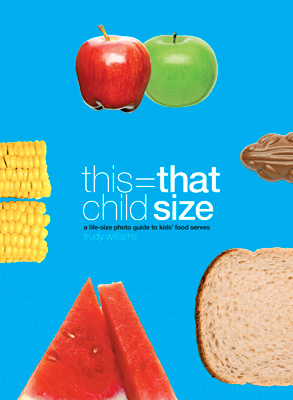This Equals That Child Size

This Equals That Child Size
Tackling the minefield of childhood obesity and providing a healthy diet for children doesn't have to be difficult or provide only 'boring' food options for children, according to the author of the first Australian life-size photo guide to kids' food serves.
Award winning Brisbane dietitian, Trudy Williams, believes that part of the childhood obesity issue has resulted from parents over-indulging their children, unaware and confused by all the information that is available on the topic of nutrition and portion sizes for children.
"We find ourselves in a situation today where both parents are working and don't have the energy or time to resist their children's demands for takeaway or other so-called 'unhealthy' food," she said.
"Originally considered special treats or party foods, these foods are now consumed every day and often in excess," she said.
However, Ms Williams said that kids do not have to be denied these altogether; they just need to be monitored.
"This type of food is organized into the red alert category in the book. Whilst these foods are not essential for health, they add interest, variety and taste to your child's day," she said.
According to Ms Williams, it becomes problematic when these foods are consumed in excess.
"If you are serious about maintaining the health of your growing child or helping to guard against further weight gain in children, pay attention to the serve sizes of 'extras'."
Ms Williams' new book, this=that child size, contains more than 342 life-size photos of different types of food to simply and clearly illustrate serve sizes in each of seven food categories, so that parents can easily see which foods to serve more or less of, in order to achieve better health and growth for their children.
"This book helps parents satisfy a child's 'needs' and balance the 'wants' in a fun way that will involve the whole family as they page through the workbook and look at the colourful photos of different foods," she said.
"Failure of a child to polish off their plate should not cause worry or concern. Nor should it cause a parent to panic to find another food to offer instead. Perhaps the child has been served too much on the plate or has eaten too much earlier in the day? It's best to assume the child is simply not hungry even if the meal has just been picked at."
According to Ms Williams, ideally a child should decide how much they want to eat from a choice of healthy foods provided by a parent. She said that this is instinct and nature at work.
"If parents don't know what to serve and children have lost the instinctive self-regulator, then this=that child size may help to restore the balance in households," she said.
In 2005, Ms Williams won the DAA President's Award for Innovation for this=that: a life-size photo guide to food serves, recognized as a novel and original book and concept for adults, now in its 2nd edition.
"The readers of the original this=that suggested a children's version. My goal in writing this=that child size was to translate complex science into a meaningful no-fuss book that helps parents offer their children great food for a healthy life and growth," she said.
"This is not a diet book. Far from it. Children need to be nourished with great food, love and attention."
How many children lack healthy diets?
The Australian National Children's Nutrition and Physical Activity Survey shows
What if children don't eat well?
Poorly balanced eating can make children sluggish or tired, moody or irritable, constipated or bloated. It will affect their school work and ability to concentrate.
In the medium term, poorly balanced eating is associated with serious health concerns such as bone growth problems, dental decay, anaemia, and lung and breathing conditions. Some children even develop high blood cholesterol, a serious marker for risk of heart disease.
The number of children who are overweight or obese has sky rocketed from just 1 in every 10 in the 1970s, to almost 1 in every 4 Australian children today.
Overweight children may also suffer heat intolerance, puffing and shortness of breath, reduced physical coordination, pain and reduced mobility due to slipped growth plates (bones), poor oxygen supply to the body due to snoring and breath-holding during sleep (apnoea), tiredness, social isolation without friends, targets for school yard and 'cyber' bullies, fatty liver, and increased risk of early 'adult' diabetes and heart disease.
All of these serious conditions are affected by what children do and don't eat, and how much they eat - their serve size.
How do children overeat?
This Equals That Child Size
Author: Trudy Williams
MORE



